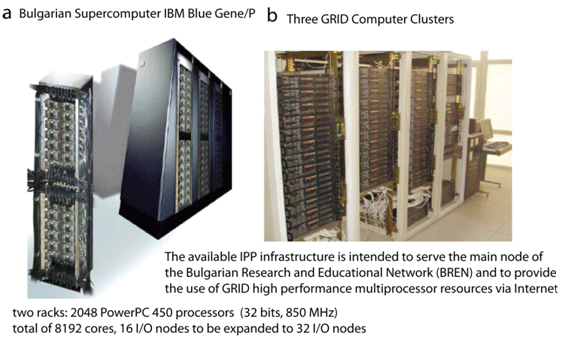|
|
 |
Login: | |
Sitemap: | Search: |
Robert Penchovsky's Website
Robert's Research
-
Computational Design of Allosteric Ribozymes
-
Engineering Gene Regulatory Networks
-
Design and Analyses of Non-coding RNAs
investigating the role of non-coding RNAs in gene regulation…
-
Molecular Computing
-
Ribozyme-based Molecular Circuit
-
Computational Drug Design
applying virtual high- throughput screening assays and rational design…
-
High-throughput Screening Assays
-
Targeting specific RNAs by antisense oligonucleotides
Inhibition of bacterail growth by targeting specific RNAs by antisense oligo- nucleotides (ASOs)…
-
Design of Programmable Microfluidic Devices
-
Software Design for Bionformatics
Lab's members
-
Professor Robert Penchovsky, Ph.D.
-
Assistant Professor Martina Traykovska, Ph.D.
-
Assistant Professor Nikolet Pavlova, Ph.D.
-
researcher Dimitrious Kaloudas, Ph.D.
-
Antoniya Georgieva, M.Sc.
-
Vanya Dyakova, M.Sc.
Main Grant Awards
-
grant:DDVU02/5/2010
Design and applications of RNA biosensors in vitro and in vivo…
-
grant:DN13/14/20.12.2017
Design and experimental validation of chimeric antisense oligo- nucleotides as antibacterial agents…
-
grant:KP-06-H31/18/13.12.2019
-
grant:KP-06-H63/1/13.12.2022
-
grant:4011/05.07.2023
-
grant:70-123-194/12.02.2024
Creation of software systems for computer-aided design of rapid allosteric ribozymes that sense the presence of sequence-defined oligonucleotides and a database of clinically relevant human genetic variation (budget: 102300 EURO )...
Research Awards
-
Dr. Penchovsky's outstanding scientist award, 2023
7th Edition of International Research Awards on SENSING TECHNOLOGY…
-
Dr. Penchovsky's award from the Bulgarian national contest, 2015
Awards for PostDocs
-
a young microbiologist national contest by the Foundation of Acad. Prof. Stephan Angeloff, 2023
-
a young microbiologist in a national contest by the Foundation of Acad. Prof. Stephan Angeloff, 2023
PhD students' Awards
-
an award from the contest student of the year 2022 of Sofia University
-
an award from the national contest "Young and Energetic Scientists", 2021
our doctoral student Antoniya Georgieva won a first prize in the Ph.D. category…
Poster awards
-
Sofia Science Festival, May 15-16, 2021
see our acknowledged poster and research project RD-22-838/2020 by BMES…
-
an award from the Congress of Micro- biologists in Bulgaria with International Participation, Hisara 2018
Another awards
-
an award from the of the EWA 2022 Start-up Competition in Bulgaria, 2022
My doctoral student Antoniya Georgieva won a second place…
-
an award for teacher of the year for 125 School, Sofia, 2022
My doctoral student Georgi Miloshev won the teacher’s prize of the year…
-
an award for a contribution to the biology education of Sofia, 2023
My doctoral student Georgi Miloshev was awarded by the Bulgarian Ministry of Education and Science…
News and views on us
-
Homo Sciens
-
Robert's live interview for the Bulgarian National Radio about his upcoming talk on the Sofia Science Festival,
-
Our lab members' interview for Science_BG: video,
-
Homo Sciens
-
Nature Biotechnology
-
Nature Methods
-
ACS Synthetic Biology
-
RSC Chemistry World
-
Sofia University
Distinction for Prof. Dr. Robert Penchovsky from the Faculty of Biology…
-
YearBoook of Research Projects at Sofia University
Design and experimental validation of chimeric antisense oligo- nucleotides as antibacterial agents…
-
Magazine of Bulgarian Science
-
Sofia University
-
Bulgarian National Science Fund
-
Bulgarian Ministry of Education and Science
-
Magazine of Bulgarian Science
-
Interview with Prof. Draga Toncheva for the Bulgarian National Radio
-
Robert's interview for Science_BG: video,
-
Martina's short interview for Science_BG: video,
-
Robert's interview for Science_BG: podcast,
-
Robert's interview for the Bulgarian National Radio
-
News papers on us in Science_BG in Bulgarian, March, 2023
-
News on the main website of Sofia University in Bulgarian, March, 2023
-
News on the main website of Sofia University in English, April, 2023
-
News on a young microbiologist national awards on website of the Institute of Microbiology, BAS, in Bulgarian, March, 2023
-
News on a young microbiologist national awards on website of the Institute of Microbiology, BAS, in English, March, 2023
-
BGlobal, in Bulgarian, July, 2023
A microbiologist replaces antibiotics when they do not work.…
-
Our recent paper is an editors' choice of the American Chemical Society. That is huge!
Computational Drug Design
A computational procedure built for virtual high-throughput screening (vHTS) of RNA and protein targets for drug discovery is presented in Fig. 1. Huge virtual chemical compound libraries are selected for a drug ability as several additional criteria related to the concrete molecular target are applied using SAS programming. The selected set of virtual chemicals from an initial pool of about three millions compounds are computationally docked into the target's binding pocket employing molecular modeling software.

Figure 1. Dataflow scheme for drug discovery based on computational high-throughput screening of virtual chemical compounds that bind specifically RNA or protein targets with known 3D-structures. Virtual chemical compounds are selected for a general drug ability using SAS programming. The 3D structures are used to compute the docking affinity of the virtual chemicals to binding pockets of RNA and protein targets. The virtual chemicals that bind the target`s pocket at least as good as the original effector are hit compounds. They are experimentally tested and the best of them are leading compounds subject to more vigorous biochemical, cell, and in vivo assays. The best lead compound is a subject of pre-clinical and clinical trials.
The computational pipeline is completely automated on a GRID computer cluster shown in Fig. 2. The compounds that are computed to bind as strong as the original effecters or even stronger are selected. The selected top ten chemicals are used for biochemical assays. All of them demonstrated a specific binding. The computational approach for vHTS is general and can easily be adapted to any targets with known 3D-structures. vHTS is a fast and accurate approach as a first step in the drug discovery endeavor that can test many millions of virtual chemical compounds and can significantly reduce the time and money spend for lead discovery. In this regard, the approach may be valuable to pharmaceutical industry and may be a commercial success testing practically unlimited virtual chemical compound libraries that even may not be available to your company research institution as real chemicals. The vHTS assays may be complementary to the real HTS arrays.

Figure 2. High Performance Computing Platforms used for computational high-throughput screening of virtual chemical compounds. The Bulgarian IBM Blue Gene/P supercomputer and GRID computer clusters were well suited for highly parallel computing tests like vHTS and can be easily operated through Internet from any place on Earth.
We also apply very often rational design of antisense oligonucleotides (ASO) attached to cell penetrating oligopeptides (CPP) for drug development.
References:
1. Robert Penchovsky & Stoilova C.C. - Riboswitch-based antibacterial drug discovery using high-throughput screening methods – 2013, Expert Opinion on Drug Discovery, 1746-0441, Q1 (Pharmacology, Toxicology and Pharmaceutics) , IF – 4,676
2. Robert Penchovsky & Martina Traykovska - Designing drugs that overcome antibacterial resistance: where do we stand and what should we do? – 2015, Expert opinion on drug discovery, Q1 (Pharmacology, Toxicology and Pharmaceutics), IF – 4,66
3. Robert Penchovsky - Computational design and biosensor applications of small molecule-sensing allosteric ribozymes – 2013, Biomacromolecules, 1525-7797, Q1 (Chemical Engineering), IF – 5,77
4. Martina Traykovska, Sjoerd Miedema and Robert Penchovsky - Clinical Trials of Functional Nucleic Acids: Antisense Oligonucleotides and Aptamers – 2018, International Journal of Biomedical and Clinical Engineering (IJBCI), 2161-1610.
5. Nikolet Pavlova, Robert Penchovsky - Genome-wide bioinformatics analysis of FMN, SAM-I, glmS, TPP, Lysine, Purine, Cobalamin, and SAH riboswitches for their applications as allosteric antibacterial drug targets in human pathogenic bacteria – 2019, Expert Opinion on Therapeutic Targets, Q1 (Biochemistry, Genetics and Molecular Biology), IF – 4,5
6. Nikolet Pavlova, Dimitrios Kaloudas, Robert Penchovsky - Riboswitch distribution, structure, and function in bacteria – 2019, Gene, 0378-1119, Q1 (Biochemistry, Genetics and Molecular Biology), IF – 2,5
7. Aikaterini Valsamatzi-Panagiotou, Martina Traykovska, Robert Penchovsky - Mechanisms of Drug resistance and Approaches to overcome it (book chapter) – 2020, Elsevier
8. Robert Penchovsky - WO 2018/197926 A1 Methods for creating novel antibacterial agent using chimeric antisense oligonucleotides (2018) WIPO
9. Robert Penchovsky - Bulgarian patent 2017112506P (2020)
10. Dimitrios Kaloudas, Robert Penchovsky - Arabidopsis Homologues to the LRAT a Possible Substrate for New Plant-Based Anti-Cancer Drug Development – 2018, International Journal of Biomedical and Clinical Engineering (IJBCE), 2161-1610
11. Katya B. Popova, Lozena A Otcheva, Martina Traykovska and Robert Penchovsky - RNA as A Potent Target for Antibacterial Drug Discovery – 2018, Biomedical Journal of Scientific and Technical Research, 2574-1241, Q4, IF – 0,548
12. Lozena A Otcheva, Nikolet Pavlova, Katya B Popova, Martina Traykovska and Robert Penchovsky - Why Some Riboswitches are Suitable Targets for Antibacterial Drug Discovery? - 2020, EC Microbiology
13. Katya B Popova and Robert Penchovsky - Why Some Functional RNAs Such as Bacterial Riboswitches are Versatile Targets for Antibacterial Drug Discovery? - 2020, EC Microbiology
14. Martina Traykovska and Robert Penchovsky - Targeting SAM-I Riboswitch Using Antisense Oligonucleotide Technology for Inhibiting the Growth of Staphylococcus aureus and Listeria monocytogenes - Antibiotics (2022)…IF:5.22 (Q1, Scopus)